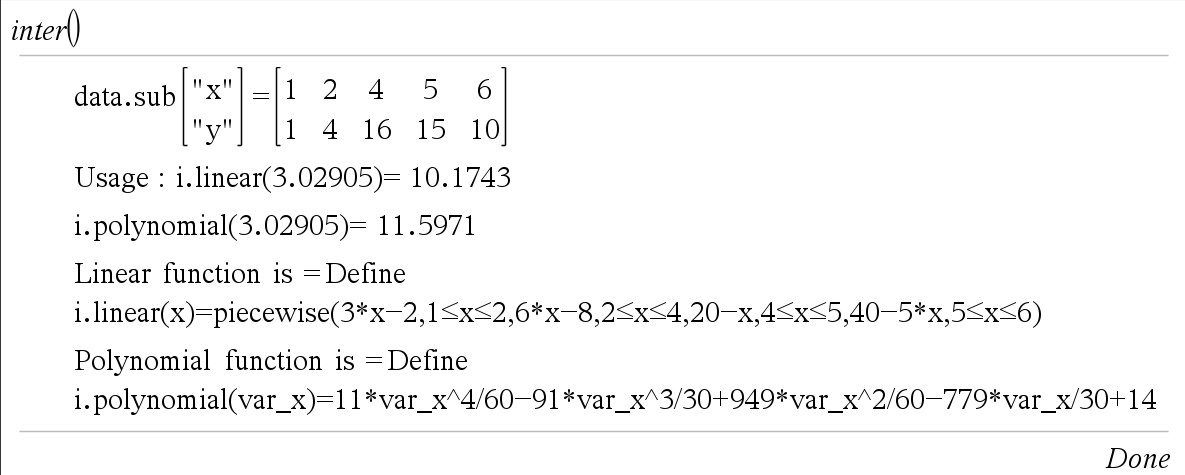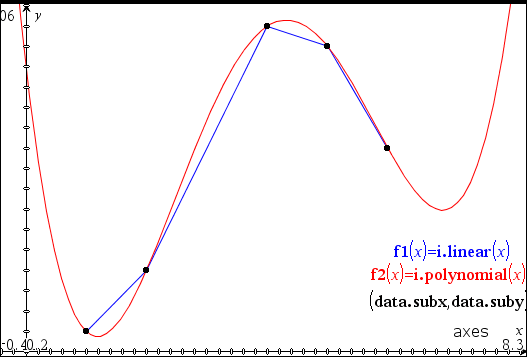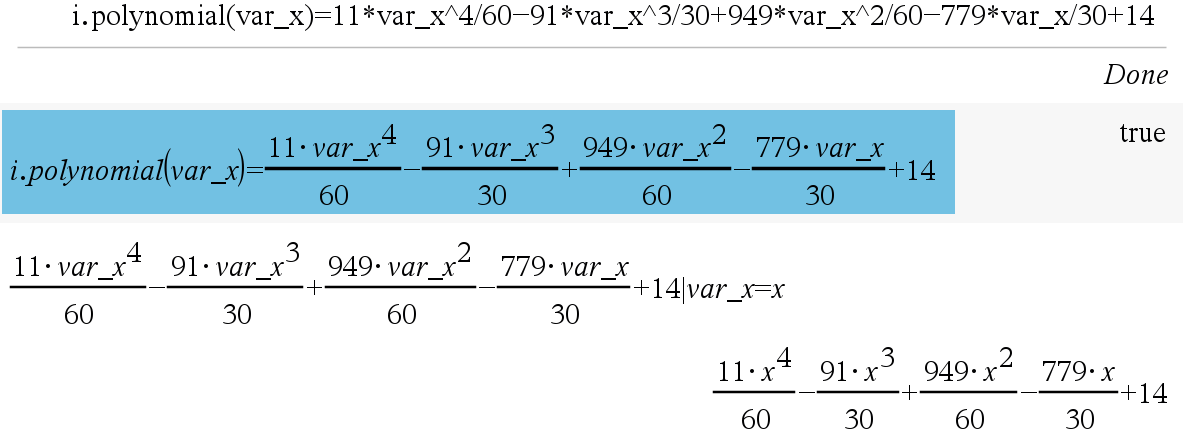- TI nspire
[TI-nspire] (프로그램) 보간법 (선형, 다항식) Linear & Polynomial Interpolation
Linear & Polynomial Interpolation for TI-Nspire
Ver 1.2
by allcalc.org
-----
Usage
1. Input each x1,y1,x2,y2... var_x and var_y alternately
or matrix (2*n) type DATA at prompt for DATA.x
2. When you finished to insert DATA, type "end" at prompt for DATA.x
3. If there's no error with DATA sets, function i.linear() and i.polynomial() will be created.
4. Use functions to find unkown value "y"
5. Additionally, data.sub(matrix) and data.subx,data.suby(list) will be made too.
Caution
To stop a program that contains a Request command inside an infinite loop:
• Handheld: Hold down the "on" key and press "enter" repeatedly.
• Windows?: Hold down the "F12" key and press "Enter" repeatedly.
• Macintosh?: Hold down the "F5" key and press "Enter" repeatedly.
1. 기능
기본 데이터를 입력하여 선형 보간법에 따른 조각함수(Piecewise Function) i.linear(x) 와 다항식 보간법(라그랑주)에 따른 함수 i.polynomial(x) 를 생성합니다.
생성된 함수를 이용하여 특정 값(x)에서의, 보간법 예상치(y)를 구합니다.
2. 사용법
2-a. 기본 데이터 입력
- 프로그램의 실행 : inter()
- 기본 DATA 입력
방법 1 : 번갈아 입력 : x1, y1, x2, y2, x3, y3... , (입력이 끝나면 e 또는 end 를 입력)
혹은
방법 2 : 2×N 행렬을 한꺼번에 입력 : x값 입력시에 입력 - DATA 입력시
 주의사항
주의사항
* x 는 크기 순서로 입력할 필요 없음 (자동 sort 됨)
* (x,y) 데이터 쌍이 중복 되어도 괜찮으나, 하나의 x값에 둘 이상의 y값이 존재하면 에러 발생
2-b. 결과 함수의 이용
- 2-a의 입력이 끝나면 결과함수로 사용할 변수명을 물어봄
- 결과함수를 이용하여 추정값을 구함
ex) i.linear(3) 【Enter】 : x=3일 때의 추정값을 구함
2-c. 생성된 함수의 확인 http://www.allcalc.org/5752
- 【MENU】 【1】 【2】 (Action - Recall Definition) 명령으로 사용자 함수에 현재 정의되어 있는 내용을 확인할 수 있습니다.
3. 결과


4. 소스코드
Define LibPub inter()=
Prgm
:© Linear and Polynomial Interpolation for TI-nspire
:© Ver 1.2
:© by allcalc (allcalc.org)
:
:© Part A: Input DATA
:
:Local n,data.x,data.y,data
:n:=0
:Loop
: Request "data.x or matrix(2×n) or END",data.x,0
:
:© Exit Loop Condition
: If string(data.x)="end" or string(data.x)="END" or string(data.x)="e" Then
: Exit
: EndIf
:
:© Adding Data
: n+1→n
:© Adding Data with Matrix
: If getType(data.x)="MAT" Then
: n+dim(data.x)[2]-1→n
: If n=dim(data.x)[2] Then
: data.x→data
: Else
: augment(data,data.x)→data
: EndIf
:© Adding Each Data Pair
: Else
: Request "data.y for x="&string(data.x),data.y,0
: If string(data.y)="end" or string(data.y)="END" Then
: Exit
: EndIf
: If n=1 Then
:[[data.x][data.y]]→data
: Else
: augment(data,[[data.x][data.y]])→data
: EndIf
: EndIf
:EndLoop
:
:© Part B : Data Processing
:
:© Part B1 : Data Processing
:Local data.listx,data.listy
:mat▶list(data[1])→data.listx
:mat▶list(data[2])→data.listy
:SortA data.listx,data.listy
:colAugment(list▶mat(data.listx),list▶mat(data.listy))→data
:
:© Part B2 : Section Verification&Consolidation and Slope
:© Verification
:Local i,j,dup
:newList(n)→dup
:For i,1,n-1
: If data[1,i]=data[1,i+1] Then
: 1→dup[i+1]
: If data[2,i]≠data[2,i+1] Then
: Disp "Data Error : ",[["x"]["y"]],"=",subMat(data,1,i,2,i+1)
: Stop
: EndIf
: EndIf
:EndFor
:
:© Consolidation
:© Local data.sub : Make data.sub global var
:subMat(data,1,1,2,1)→data.sub
:For i,2,n
: If dup[i]=0 Then
: augment(data.sub,subMat(data,1,i,2,i))→data.sub
: EndIf
:EndFor
:
:mat▶list(data.sub[1])→data.subx
:mat▶list(data.sub[2])→data.suby
:Disp "data.sub",[["x"]["y"]],"=",data.sub
:
:© Slope for Linear Interpolation
:Local sub.slope,sub.n
:dim(data.sub)[2]→sub.n
:newList(sub.n-1)→sub.slope
:For i,1,sub.n-1
:((data.sub[2,i+1]-data.sub[2,i])/(data.sub[1,i+1]-data.sub[1,i]))→sub.slope[i]
:EndFor
:
:
:© Part C1 : Out Polynomial Function as i.polynomial(x)
:Local poly,f_name
:"i"→f_name
:Request "Input Function name",f_name,0
:If getType(f_name)="NUM" Then
:"i"&string(f_name)→f_name
:Else
: If getType(f_name)≠"STR" Then
: string(f_name)→f_name
: EndIf
:EndIf
:
:"Define "&f_name&".polynomial(var_x)="&string(∑(data.sub[2,i]*∏(when(i≠j,((var_x-data.sub[1,j])/(data.sub[1,i]-data.sub[1,j])),1),j,1,sub.n),i,1,sub.n))→poly
:expr(poly)
:
:© Part C2 : Out Piecewise Linear Interpolation Function as i.linear(x)
:
:Local pf,random.x
:"Define "&f_name&".linear(x)=piecewise("→pf
:For i,1,sub.n-1
: pf&string(sub.slope[i]*(x-data.sub[1,i])+data.sub[2,i])&","&string(data.sub[1,i]≤x≤data.sub[1,i+1])&","→pf
:EndFor
:left(pf,dim(pf)-1)&")"→pf
:expr(pf)
:
:© Part C3 : Display functions usage
:rand()*(data.sub[1,sub.n]-data.sub[1,1])+data.sub[1,1]→random.x
:Disp "Usage : "&f_name&".linear("&string(random.x)&")=",#(f_name&".linear")(random.x)
:Disp f_name&".polynomial("&string(random.x)&")=",#(f_name&".polynomial")(random.x)
:
:Disp "Linear function is =",pf
:Disp "Polynomial function is =",poly
:EndPrgm
댓글10
-
세상의모든계산기
이 프로그램은 선형 보간법과 라그랑주 보간법을 동시에 구하는 프로그램입니다.
간단하게 선형 보간법의 결과만 필요한 경우에는
별도의 프로그램 파일 혹은 라이브러리를 사용하기보다 statistics(통계) 의 Linear Regression 기능을 이용하는 것이 편합니다.(예제 : http://www.allcalc.org/7826 )
- 1
-
세상의모든계산기
예를 들어
http://www.allcalc.org/2387 의 댓글에 있는 예제를 푼다면
【inter()】
【200】【1250】
【300】【1890】
【e】【Enter】
순으로 DATA 입력을 마치고【i.linear(250)】
으로 목표값을 찾습니다.* 이렇게 DATA 가 2쌍 뿐인 경우에는 i.linear() 함수와 i.polynomial() 함수가 동일한 결과값을 출력합니다.
(단, linear() 함수는 조각함수라서 데이터 범위 안쪽의 값만을 구할 수 있습니다.) - 1
- 2
- 3
- 4
-
3
세상의모든계산기
inter() 함수 결과에 생성된 함수를 출력하는 명령(Disp)을 추가했습니다.
한 줄 표기되어서 알아보기 어렵다고 느끼실 때는
- Menu - Action - Recall Definition
- 아니면 한 줄 표기된 결과를 선택해서 입력창에 붙여넣기 하신 다음 [enter] 하시면 입체적 표현으로 바뀝니다.



세상의모든계산기 님의 최근 댓글
일반 계산기는 일반적으로 세팅이나 리셋기능이 따로 없기 때문에, 다른 요인에 영향을 받을 가능성은 없어 보이구요. '원래는 잘 되었는데, 지금은 설정 값이 날아간다'면 메모리 값을 유지할만큼 배터리가 꾸준하게 공급되지 않기 때문일 가능성이 높다고 봐야겠습니다. - 태양광이 있을 때는 계산은 가능하지만, 서랍등에 넣으면 배터리가 없어서 리셋 https://blog.naver.com/potatoyamyam/223053309120 (교체 사진 참조) 1. 배터리 준비: * 다이소 등에서 LR54 (LR1130) 배터리를 구매합니다. (보통 4개 들이 1,000원에 판매됩니다. LR44와 높이가 다르니 혼동하시면 안됩니다.) 2. 준비물: * 작은 십자드라이버 (계산기 뒷면 나사용. 이것도 없으시면 다이소에서...) 3. 커버 분해: * 계산기 뒷면의 나사를 풀고, 머리 부분(윗부분)의 커버를 조심스럽게 분해합니다. (참고해주신 블로그 사진을 보시면 이해가 빠르실 겁니다.) 4. 배터리 교체: * 기존 배터리를 빼냅니다. * 새 LR54 배터리의 '+'극 방향을 정확히 확인하여 제자리에 넣어줍니다. (대부분의 경우 '+'극이 위로 보이도록 넣습니다.) 5. 조립: * 커버를 다시 닫고 나사를 조여줍니다. * 블로그 사진을 보니 배터리 연결선 등이 눌려서 씹혀 있네요. 원래 씹히도록 설계를 안하는데, 원래 그렇게 만들어 놓은 건지? 모르겠네요. 여튼 씹히면 단선될 가능성이 있으니, 잘 보시고 플라스틱 틈새 등으로 적절히 배치해서 안씹히게 하는 것이 좋습니다. 6. TAX 재설정: * 계산기의 전원을 켜고 TAX 요율을 10%로 다시 설정합니다. 2025 12.10 TI-nspire 입력 방법 solve({x+a+b=5,x)|a=1 and b=2 2025 12.01 질문하실 때는 항상 계산기 모델명을 정확하게 적으셔야 합니다. 2025 12.01 참고 - [공학용 계산기] 로그의 입력 (log, ln) (feat. 밑 입력이 안되는 계산기는?) https://allcalc.org/14995 2025 11.14 HP-39gII 에 ExistOS 설치하기 https://allcalc.org/38526 2025 11.07